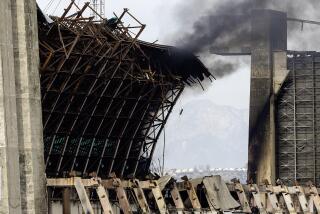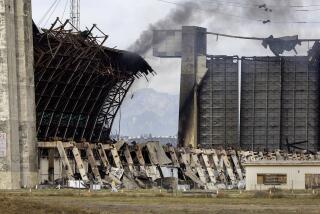Navy Team Boards Ranger to Investigate Asbestos Contamination
- Share via
In an effort to make sure that the aircraft carrier Ranger is free of cancer-causing asbestos fibers, a team of investigators went aboard Thursday after the vessel docked in San Diego.
The Navy also hopes to figure out who--if anyone--was exposed to airborne asbestos fibers after a San Diego-based company carelessly ripped asbestos out of the ship last winter when sailors were aboard.
“My paramount concern is the importance of ensuring the health and safety of the crew,” said Vice Adm. John H. Fetterman Jr., Commander of the Pacific Fleet’s Naval Air Forces. “I am dedicated to addressing, to the best of our ability, the extent of any possible exposure to asbestos.”
Capt. Charlie Robinson, the Pacific Fleet’s Naval Air Force safety officer, boarded the vessel with several experts--including an industrial hygienist, medical personnel, a naval occupational health and safety specialist, and a representative from the Norfolk-based Environmental Preventive Medicine Unit. The team plans to sample air in various areas of the Ranger, checking to see if any airborne asbestos fibers are still present.
They also will talk to sailors who might have been in areas where asbestos was carelessly removed and attempt to assess the extent of exposure, Fetterman said. The team will evaluate its initial findings and “advise of the appropriate course of action,” he said.
“Since the asbestos removal occurred approximately six months ago, it is not only necessary to conduct current air sampling in areas of asbestos removal, but to thoroughly reconstruct and assess what occurred at the time of removal and what safety procedures were employed by the subcontractors, by supervisor of shipbuilding and by ship force personnel,” Fetterman said.
And the process will not be easy, though preliminary results are expected in several days, Robinson said.
“It’s challenging, certainly, to go back after the fact and determine what took place, but we feel we need to do that to make sure we don’t hazard the safety of our people,” Robinson said.
Asbestos was once widely used as insulation but was banned in 1979 for most construction purposes when experts realized that it caused health problems. Asbestos is dangerous if it is inhaled into the lungs, where even one microscopic fiber can cause a fatal disease, such as cancer or asbestosis, a deadly lung ailment.
The Ranger is host to 5,000 sailors at sea and about 2,800 when docked. Crew members were informed this week of the possible hazard by their supervisors during quarters, when each department gathers, said Lt. Cmdr. Bob Pritchard, a Navy spokesman.
Last week, California Marine Commercial Insulation and company president Frank Chavez pleaded guilty to failing to take adequate precautions when they removed more than 260 feet of asbestos-covered pipes. CMCI worked intermittently aboard the Ranger while the ship was docked at North Island from September to March.
CMCI workers failed to wet, bag and label the asbestos properly as workers tore it from various areas of the ship. Workers also neglected to seal off the ship’s ventilation system, which might have transported asbestos fibers to a number of areas in the ship, said U.S. Atty. Melanie K. Pierson.
Former CMCI workers told The Times last week that they ripped out crumbling asbestos in bathrooms, berthing rooms, stairways, and the brig of the ship while sailors used those areas. The workers often wore no protective clothing or respirators, they said. They also toted dust-laden pipes and insulation through the ship, piling it up on pallets in the hangar deck, leaving it loose until the pallet filled. Then they unloaded those pallets into a pier-side waste bin--all violations of procedures, since the actions could release asbestos fibers into the air, experts say.
“We trust a lot of folks who come aboard to do the job and do the job right,” Robinson said. “We have to assume that’s what they are going to do if they sign the contract.”
More to Read
Sign up for Essential California
The most important California stories and recommendations in your inbox every morning.
You may occasionally receive promotional content from the Los Angeles Times.













